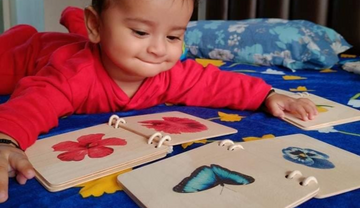As parents, we always want to do what’s best for our children, especially when it comes to their growth and development. But did you know that what they see in their early years plays a pivotal role in shaping how their brains develop? While children’s books and toys often feature colorful, whimsical images, exposing your little one to realistic images is not just beneficial—it's essential. Unrealistic images can confuse your child’s understanding of the world and hinder their cognitive growth. Read on to discover why realistic imagery matters and how it can boost your child’s development in more ways than one.
The Power of Early Brain Development

By the time your child turns six, their brain will have developed around 90% of its full capacity. Yes, you read that right! And even before they turn three, a staggering 80% of their brain development occurs. This rapid development is your child's brain adapting to the world around them, processing sensory inputs, and absorbing as much as possible from their environment. The goal? To help them grow into an adaptable, knowledgeable individual who understands their time, place, and culture.
This rapid brain growth is why it's critical to expose your child to real, accurate images from the start. Realistic images provide your child’s brain with a concrete understanding of the world, helping them build the mental foundation for everything they will learn. Introducing your child to objects in their true form—not in exaggerated or abstract representations—makes it easier for them to comprehend and make sense of their surroundings.
Why Realistic Images Matter? 
When your child first encounters an object, their brain is busy processing new information. Imagine they are shown an unrealistic or cartoonish version of something—say, a wildly exaggerated apple in a cartoon. This can create confusion, making it difficult for them to connect what they’re seeing with what they will encounter in real life.
Instead, showing them the actual apple or a realistic image of one allows them to understand its true shape, size, texture, and color. The more accurate the image, the better your child’s brain can make sense of it. It’s about creating a realworld connection, ensuring their early experiences match reality.
HandsOn Learning: A Vital Experience
One of the best ways to help your child process the world around them is through hands-on learning. Allow your little one to touch, feel, and even smell real objects when possible. For example, a basket of fresh fruit provides not just a visual experience, but a sensory one. They get to explore the texture of the fruit, feel its weight, and even experience the scent. This sensory interaction forms connections in their brain that support cognitive development.
However, we know that not every object is something you can bring into the home. That’s where figurines come in. But don’t just opt for any figurines—ensure they are realistic and proportionate. For example, if you’re showing your child animals, the figurines should reflect the real size and shape of the animals to help them understand the world more accurately.
Realistic Imagery in Our Products
At Ariro Toys, we are committed to providing products that support your child's development with realistic images. Our toys feature lifelike images that are not only proportional to each other but are also reflective of what your child may encounter in their realworld environment. For instance, our rotating puzzles showcase realistic images of species native to India, connecting your child with their surroundings in a meaningful way.
These realistic images encourage children to explore and understand the world around them, ensuring they are building a strong mental framework that matches the reality they will soon navigate.
Flora and Fauna: Context Matters
When it comes to introducing animals or plants to your child, context is everything. Let’s say you hang a lion or a hippo from a mobile above your baby’s crib. This can be very confusing, as these animals do not naturally live in the same environment. Introducing animals alongside their natural habitats, however, will help your child form a more accurate mental map of the world.
A Strong Foundation for Lifelong Learning
Early childhood is a crucial period for brain development. The experiences and images your child is exposed to now will shape their cognitive abilities and their understanding of the world. By focusing on realistic images—whether through handson exploration, realistic toys, or carefully selected imagery—you are giving your child a strong foundation for learning.
These early, realworld experiences help your child process information accurately, build strong neural connections, and ultimately, grow into a confident, adaptable learner. So, the next time you introduce an object, a toy, or a picture, ask yourself: “Is this a true representation of the real world?” The more you can say yes, the better it will be for your child’s brain development.
References:
The Science of Early Childhood Development, Harvard University, Center on the Developing Child https://developingchild.harvard.edu
Brain Development in Early Childhood, American Academy of Pediatrics https://pediatrics.aap.org






